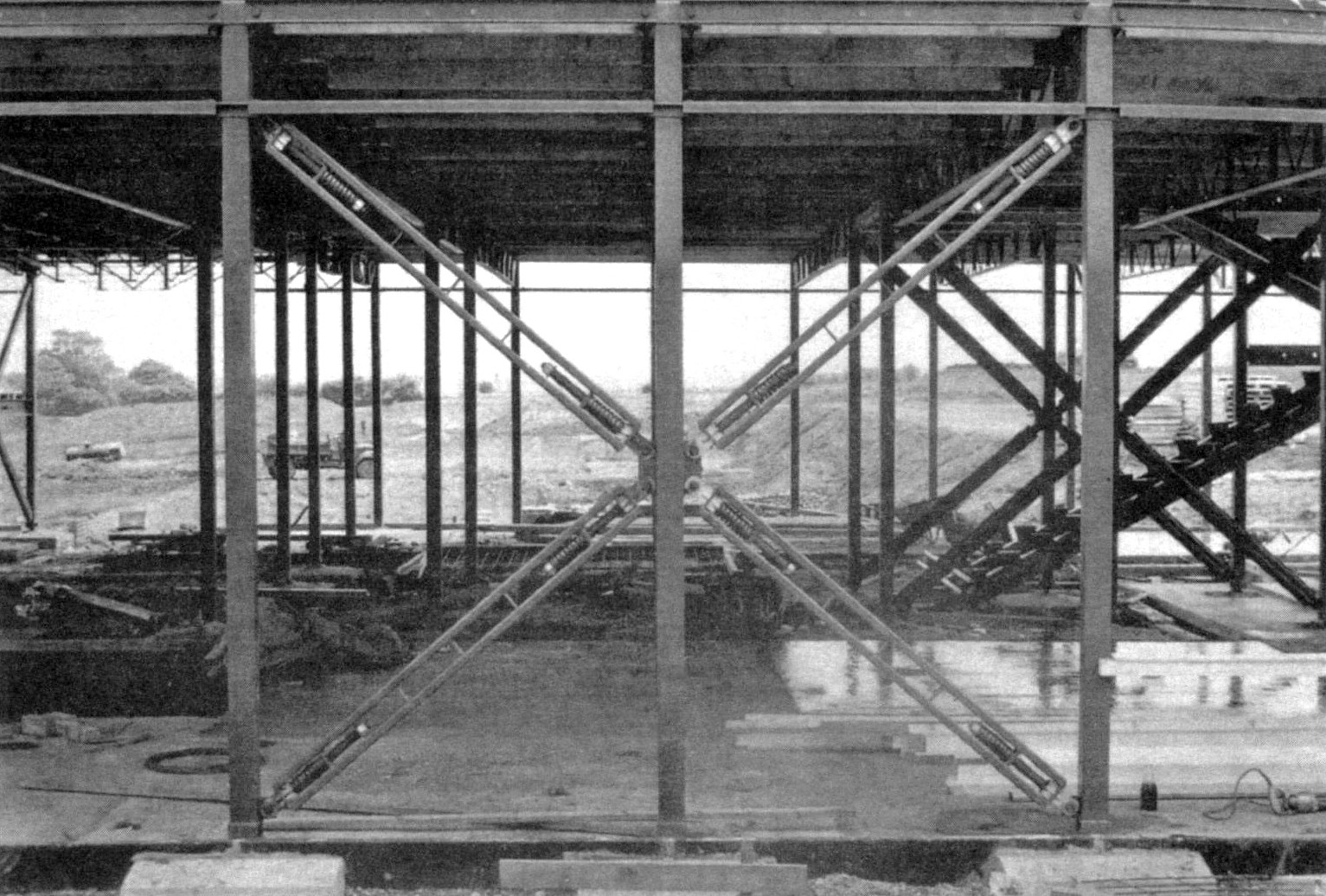
In the United Kingdom, the Education Act of 1944 introduced secondary schooling for all children in government funded education, with a system of grammar, technical grammar, and “secondary modern” schools, for which pupils were selected by an intelligence test. The problem for Nottinghamshire was a shortage of grammar and technical schools: there were none outside of the county’s two main industrial centers, Nottingham and Mansfield in the western half of the county.[1] After 1945, the county architect E.W. Roberts set out to resolve the problem, along with building primary schools to meet the fast-growing population and dealing with larger problems of subsidence in mining areas. Like other county councils, Nottinghamshire planned a program of building for some five or so years ahead, which was taken forward on a year-by-year basis as government funding allowed. There were also shortages of other public facilities such as libraries and fire stations. The building of schools and public buildings by his successors became umbilically linked with a flexible, steel-framed system designed to be economical, quick to build, and above all to withstand subsidence. To do this, they marketed the system in 1957 with other mining authorities as the Consortium of Local Authorities Special Programme (CLASP).
The need for schools was nationwide. To meet a fast-growing demand as thousands of families migrated from London, Hertfordshire County Council’s team of architects produced a series of attractive, prefabricated primary schools. Such was their success that many of these architects were headhunted into the Ministry of Education’s Architect and Building Branch, which sought to develop a similar system for the multi-story buildings needed by new secondary schools. One testing ground was Coventry, whose architect Donald Gibson conducted experiments with a system developed by F.W. Heathcote, engineer to Brockhouse Steel Structures, a Midlands engineering firm previously specializing in military vehicles.[2] The lightweight steel frame required no deep foundations or piles, and included its own bracing.[3] Brockhouse built a few schools for Essex County Council, but the system attracted attention only when it was adopted by the Ministry, who refined it from an 8’–3” bay approach to a neater 3’–4” grid for an experimental secondary school at Belper, Derbyshire.
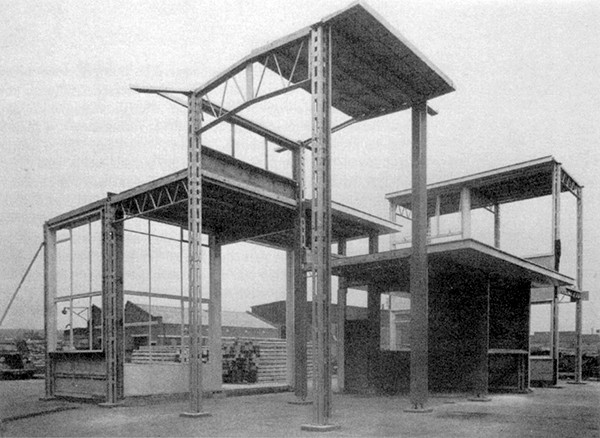
The Problems in Nottinghamshire
In late 1954, Donald Gibson succeeded Roberts as county architect to Nottinghamshire, a county similar in population to Hertfordshire but whose rapid expansion in light engineering and coalmining had led to a paucity of public buildings. By the time of his retirement, Roberts had built fifty-four stout brick schools, a teacher training college, and two technical colleges.[4] The budget of the annual program was worth about £1 million, but by 1955 was alarmingly behind schedule. This was partly due to a shortage of materials, plasterers, and bricklayers that was blamed on the demand for power stations in the Trent Valley. But a greater problem in Nottinghamshire was subsidence, the sinking of the ground when seams of coal were extracted from beneath buildings. Since schools were often the largest structures in a mining village they felt the problem acutely. Roberts’s team had used very heavy concrete foundations which formed a bridge-like structure, recommended by the Building Research Station. These foundations cost ten percent of the county’s building budget, far higher than the Ministry of Education normally allowed, yet the schools still cracked. Eight of the eleven sites identified for Nottinghamshire’s 1957–1958 building program were in areas liable to subsidence. Gibson, with an authority born of his achievements at Coventry, promised to find a solution in two years.
To buy time, Gibson built the 1956–1957 annual program of fourteen schools using an existing timber system called Derwent, developed by a local builder Vic Hallam in 1950–1951 at Langley Mill for one or two-story structures with subsidence in mind. Gibson, meanwhile, built up a team of young architects. He recruited two architects from Hertfordshire, appointing W. D. (Dan) Lacey as his deputy and Henry Swain to lead a new development group. The two complemented each other, Lacey the level-headed one, and Swain “a rare combination of romantic rebel and a good technician.”[5] By September they had been joined by Alan Goodman, A.E. Metcalf, David Moizer, and Alan Meikle, the latter having worked at Hertfordshire after training at Birmingham School of Architecture, another valuable source of assistants. Derek Lakin, David Meylan, Bevis Fuller, and Wally Wilson were there by December.
Gibson thought Roberts’s deep concrete foundations were illogical. He was fascinated by trains, and argued that the Flying Scotsman, which weighed 200 tons yet ran on rails, proved that very heavy moving loads could be held on almost nothing. He, Lacey and Swain evaluated thirteen existing construction systems with the Ministry of Education in September 1955. They claimed not to look at educational needs, but rather—in hierarchical order—at cost, speed of erection, site labor, maintenance, flexibility, stability faced with mining subsidence, mechanical properties and appearance. They also studied furniture.[6]
Gibson, Swain, and their team found a solution in a pin-jointed steel frame that could ride on a raft foundation. The Hertfordshire system had been sourced from Hills, an engineering firm in West Bromwich, but by 1955, they were no longer reliable suppliers and it had proved difficult to push their frame above two stories. In November 1955, therefore, Nottingham selected Brockhouse, whose system was not only pin-jointed and lightweight, but which had been shown to be suitable for three stories. “When the builders did their test frame, Lister [Heathcote] was there with a big smile—he saw it as the biggest chassis he ever designed,” recalled Alan Meikle, who speaking in 2012 likened a CLASP school to a ship riding a giant wave as coal was extracted from below.[7] Swain was excellent at math and secured the confidence of W.H. Ward of the Building Research Station and Kenneth Wardell, a surveyor at the National Coal Board, whose paper on mining subsidence enabled the architects to calculate the degree of movement transferred to a building.[8]
The frame was refined by the Nottinghamshire architects working with Heathcote, the Ministry, and R.C. Coates of Nottingham University to produce a distinctive cross bracing on springs. They then looked at flexible claddings, including weatherboarding, asbestos cement sheets, slate and tile hanging, with windows in timber surrounds. Services were a greater problem, and drains were put in oversized holes so they could move slightly; Meikle remembered that in seeking further flexibility, Swain favoured pitch fibre pipes.[9]
The first school built using what would become the CLASP system was Bancroft Lane Infants’ School at Mansfield, quickly renamed Intake Farm. The builders Simms, Sons, and Cooke, already erecting the Derwent school program, built Bancroft Lane after erecting a mock up in their yard close to the university at Lenton. The designs and budget for Bancroft Lane then formed the basis of negotiated contracts for ten other schools in the 1957–1958 program, as well as a county supplies depot and fire headquarters in Kiddier Avenue, Arnold. The use of a single system built by a single firm meant that the cost of tools and overheads could be spread over a number of jobs, and suggested that the system could be still more economical if there were more orders.[10] The eventual winners for the program were Searsons, contractors based in Kirkby-in-Ashfield. CLASP proved popular for its economy and flexibility as well as its suitability for poor ground conditions. The mass production and bulk ordering of components, and serial contracting for a whole building program, kept tenders down and ensured that the price of materials and components remained stable as inflation grew in the coming decades.[11]
Nottinghamshire’s director of education, J. Edward Mason, recalled that before CLASP he and his chief officers had prepared briefs for new schools almost in isolation, and welcomed the greater collaboration with the architects that accompanied the introduction of the new program.[12] The first brief, for primary schools, allowed more space for children’s activities by reducing circulation areas and created a more informal atmosphere. Semi-standardized plans placed small lavatories between pairs of classrooms, where they could be easily supervised, and the architects designed their own child-sized furniture.
The earliest secondary schools were built at Tuxford and Retford Ordsall (both demolished). They comprised informal ranges of classrooms, laboratories, and workshops set loosely around a central entrance and library area. The frame system enabled ground-floor areas to be kept open to create vistas into partially enclosed courtyards, a feature that was repeated elsewhere. Systems of house rooms to break down very large schools were developed once larger comprehensive schools for children of all abilities began to be built as education authorities came to reject selective schooling. The first was at Ollerton, designed using CLASP as early as 1961 for 1200 children, with craft rooms gathered round a semi-open courtyard and six house rooms.[13] Many comprehensives featured a concert space or theater rather than a large hall.
Lacey and Swain were adamant when talking about their work that they “ don’t want aesthetics—you look after the children and the components, and the aesthetics will look after themselves.”[14] They were delighted when the Architects’ Journal quoted the claim of a private architect writing on CLASP that “it is not Architecture.”[15] Such was their confidence that no less than 213 CLASP buildings were constructed before the structural resilience of the system was put to the test in 1962, when five schools, including Intake Farm, “rode” the excavation of coal from underneath with only modest repairs required.[16] From 1972–1974 a survey was made of all Nottinghamshire’s CLASP buildings, which found that only nineteen out of seventy exposed to mining operations had been damaged, costing a total of just £3,288 to repair.[17]

The Formation of CLASP
The 1957 building program was too small to meet the minimum order of 400 tons of steel on which it was budgeted. It was saved when Gibson telephoned Coventry and brought in an additional school, Willenhall Wood. The Minister of Education, Lord Hailsham, welcomed this collaboration and offered bonuses, leading Gibson to devise the idea of a consortium of local authorities that jointly developed and managed a common system. Gibson’s network, and that between councilors sharing a mining background, brought in Coventry, Derbyshire, County Durham, Glamorgan, Leicester, and Yorkshire’s West Riding to found the Consortium of Local Authorities Special Programme with Nottinghamshire. “Special” was substituted for “schools” at Swain’s insistence to show that the system could be used for all kinds of projects.[18]
Gibson became the first chairman of CLASP, and he continued in this role after leaving Nottinghamshire in 1958 for the War Office, which he brought into the consortium. At the county council he was succeeded by Lacey and then by Swain, who served as Nottinghamshire’s chief architect until his retirement in 1988, and came to personify CLASP in particular and the county’s architecture in general. The Ministry of Education and Scottish Education Department joined CLASP in the early 1960s, followed by York, Bath, and Cambridge Universities, the University Grants Committee, and Scottish Health Service. Small authorities and Roman Catholic dioceses became subordinate “associate members,” but larger counties were encouraged to form their own consortia.[19]
Nottinghamshire’s 1958–1959 building program was for thirty-one schools, at a total cost of £2,500,000, and forty-six were included in that for 1959-60, costing £3m. The real growth came in 1961–1962 with a program of fifty-seven buildings costing £6,700,000, and in 1963–1964, with 103 jobs costing £10,600,000.[20] This expansion was remarkable, given the limited take-up of the Ministry’s earlier research work. In 1963, schools represented sixty percent of the program, and further education buildings including the University of York nearly half of the rest. By then Nottinghamshire was using CLASP for all its buildings.
The seal was set on CLASP’s success when an exhibition version won an award at the Milan Triennale in 1960. Devised by Trevor Prosser, it bore similarities to his school of 1958 at Barnby Road, Newark (demolished).[21] The three classrooms and assembly hall, built in nine weeks within the normal Ministry cost limits, with furniture and fabrics by the Ministry and CLASP, was laid out with creative toys by the exhibition designer James Gardner to demonstrate creative learning techniques and visual stimulation for an imaginary group of children. It led to modified versions of CLASP being ordered from Brockhouse by local authorities in Germany and Italy, later followed by larger programs in France.
In its early days, the CLASP consortium was voluntary and without legal status. The chief architects met a few times each year and hosted an annual conference by turn, showing off their buildings, while a working party discussed further developments to the system. All the prototype schools built to demonstrate a new form of CLASP were in Nottinghamshire, which continued to lead the program.

The Evolution of CLASP
Brockhouse supplied the early frames, but after Gibson brought in the Ministry of Works in 1961, the Treasury insisted that a competitive tender was obtained for their part of the program, which was won by the builders Saunders & Forster. When the whole consortium went out to tender, Saunders & Forster won that too.[22] Claddings, windows, and other fixtures were sourced from across the country.
CLASP Mark 1 was taken as the Brockhouse system. This had an ill-fitting glazing system, and Nottinghamshire developed its own sliding glass panels in an aluminum frame for its own system, Mark 2. A rather complex clerestory glazing pattern inherited from Brockhouse became a distinctive feature of early CLASP systems, using high-quality frames of Columbian pine or Iroko hardwood as at Intake Farm School. A lighter frame with cheaper redwood windows (a false economy, as they rotted), was introduced as Mark 3 in 1961. Cladding was of concrete panels, aluminum sheets or tiles, or horizontal boarding where the risk of fire was low. Since its in-house architects were tied up with schools, Nottinghamshire farmed out a few of its projects, notably its public libraries, to private architects, including Alan Goodman’s practice Grey Goodman & Associates and Robert Matthew, Johnson-Marshall & Partners.
A distinctive feature of early CLASP was its cladding in tiles, a traditional method used in Kent and Sussex to cover timber-framed buildings so that they superficially looked to be built of brick. A thick, heavily profiled tile was specially devised by the artist Hans Coper and used in 1965 at East Leake Health Centre, Nettleworth Infants School in Mansfield Woodhouse (by David Meylan), and Newark Orchard School.[23] A sharply pointed top light was adopted after it was developed for the University of York, and a projecting bay window unit was first used at the Sutton Centre, Sutton-in-Ashfield. Criticism of CLASP’s folksy qualities gave way to attacks on its concrete austerity, but most often it was associated with the mundanely decent.
In 1961 CLASP set up its own development team at Nottingham under Sydney Bell, another ex-Birmingham student appointed by Gibson in 1956. He first headed a team of four architects, appointed to refine Mark 3, introducing a cambered roof truss so that roofs were not entirely flat and a better range of windows that became Mark 3B.[24] CLASP Mark 4 followed, first used for the Newlands Junior School at Clipstone, built in 1965–1966 with RW Cheney as the job architect. Bell sought to reduce the weight of steel in the beams, to increase the number of standard components, and reduce the amount of skilled site work, notably by devising floor and roof decks in prefabricated sections. A three-foot grid imposed by the Ministry of Education gave greater flexibility.[25] Simplified windows arrived from the factory glazed and painted, and doors were pre-hung in their frames.[26]
Mark 4 offered greater flexibility for non-school, particularly residential buildings, where smaller rooms were required. CLASP was used in university building at York, Cambridge, and Bath, all by Robert Matthew, Johnson-Marshall & Partners. It was extensively used for hostels serving schools and colleges in rural Scotland, and was related to the experimental “5M” five-meter-housing system developed by the Ministry of Housing and Local Government for an estate in Sheffield.[27] CLASP Mark 4B, first used in 1969, introduced refinements to the windows, partitions, and stairs, and was designed for higher education as well as for primary and secondary schools. CLASP also developed its own ranges of furniture, initially employing two furniture designers and (through Gibson) securing assistance from the Ministry of Public Building and Works. Bob Sutton from CLASP developed the Forme range in 1969 with the Ministry of Education, which was manufactured by Pel Limited.[28]
Mark 5, introduced in 1971–1972, was metric. First used at Dalestorth Primary School in Nottinghamshire, it was cheaper, having fewer components and simpler site operations, yet looked more sophisticated. Steel and concrete replaced the last elements of timber in the roof and upper floors, partly to increase fire resistance, and windows were plastic-coated for ease of maintenance.[29] Most Mark 5 buildings were clad in concrete panels, given a white, red, grey, brown, or green aggregate finish in the casting. Experiments were first made in 1972 using brick as a cladding to meet resistance to the use of CLASP in historic areas, and in 1973 a health center at Mansfield Woodhouse used stone slates from a demolished building. Pitched and hipped roofs became a regular feature, beginning at Warren Primary School, Top Valley, Nottingham, in 1976–1977. As modernism went out of favor, the use of brick and pitched roofs coincided with a move from a closed to open system: the secret of CLASP’s longevity and evolved with Mark 6 in the 1980s. The first new school to consider energy saving in its design was Wood Lane Primary, Hucknall, in 1977 (demolished).
A study by Norman Sidwell of Heriot Watt University in 1970–1972 found that CLASP structures required no more or less maintenance than other buildings.[30] The biggest problem was fire, which could spread through voids, usually between the ceiling and roof. More fire stops were introduced after a fire in a school science block at Leicester in 1965, but thereafter arson emerged as a growing problem in schools. The most serious fires were in old people’s homes in the early 1970s, usually started by a cigarette.
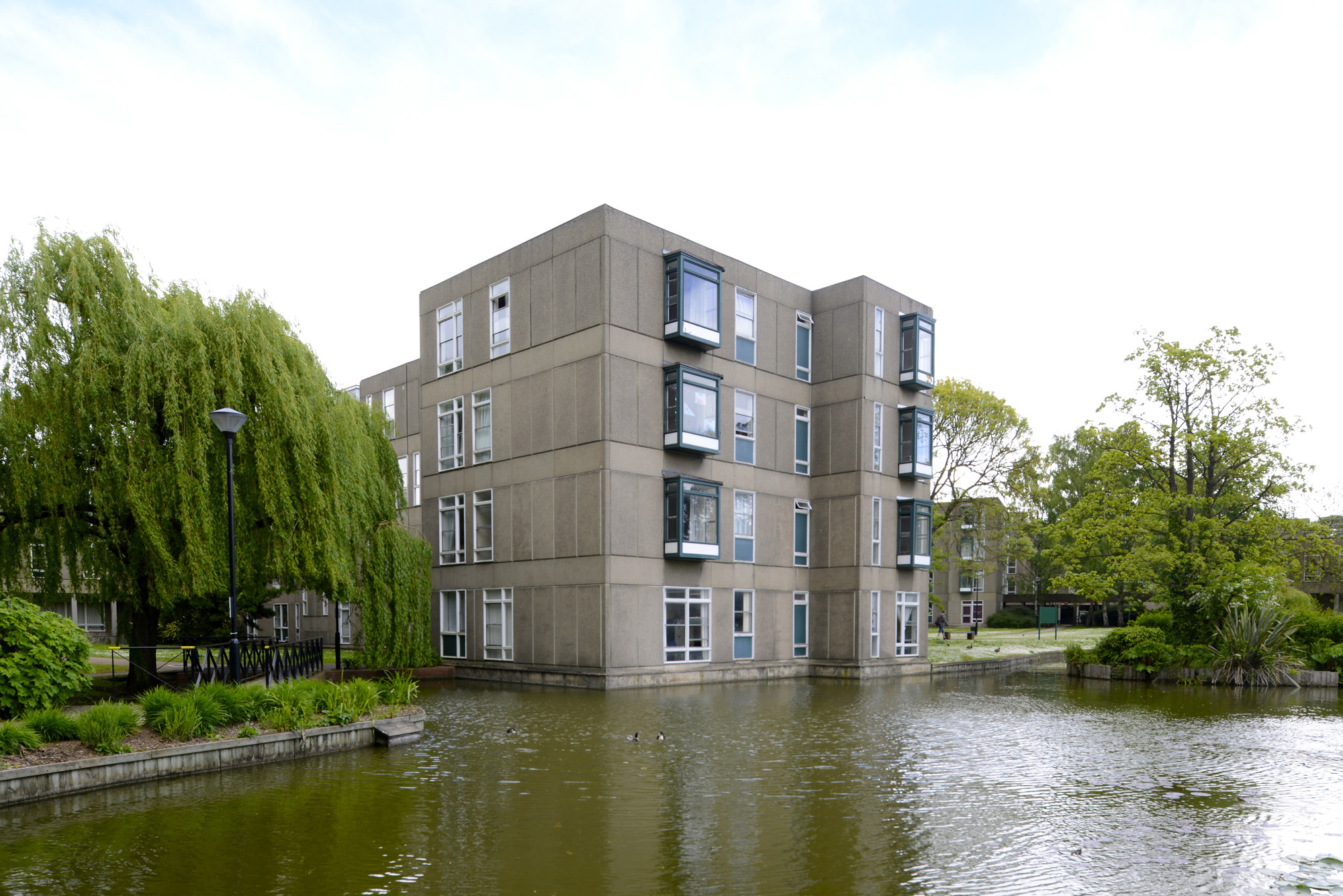
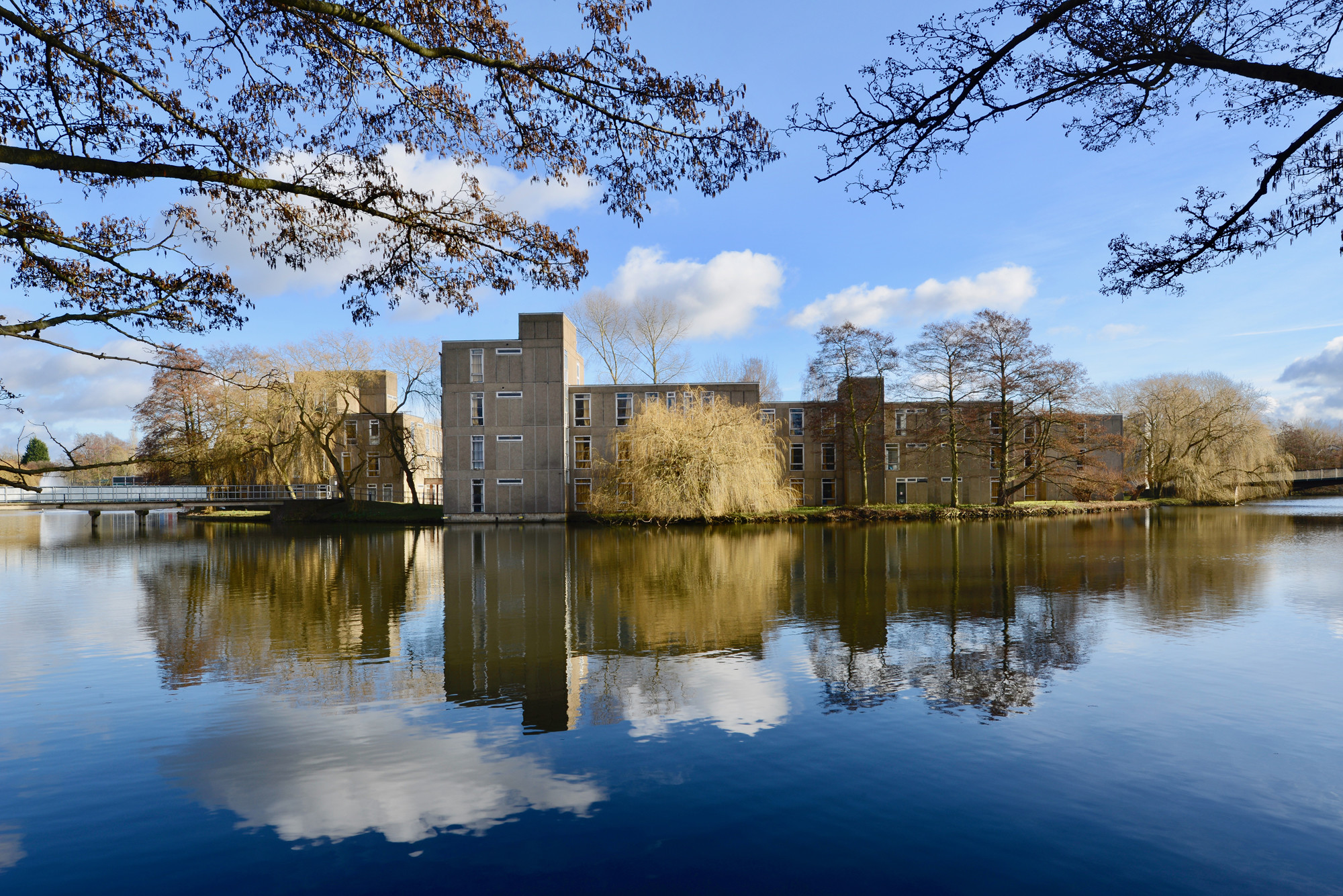
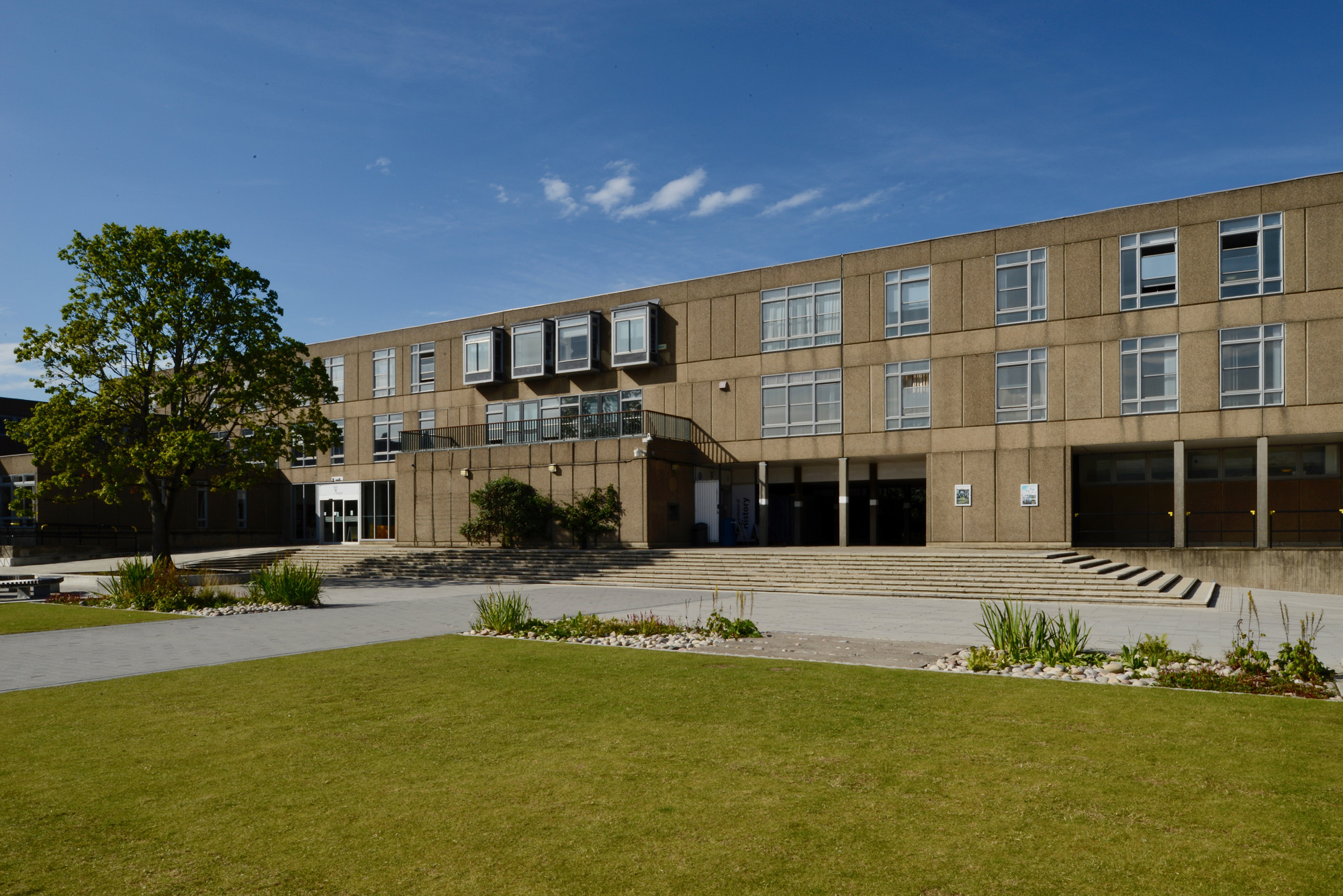
CLASP Today
CLASP continued to be refined until 2005, by which time Mark 6B was in production, as seen at Oakwood School, Manchester, with exposed steel, aluminum finishes, and a curved roof, as well as in brick-clad extensions to the Cavendish laboratories in Cambridge. In April 2006, CLASP became part of Scape System Build Ltd, a local-authority controlled company wholly owned by Derby City, Derbyshire, Gateshead, Nottingham City, Nottinghamshire, and Warwickshire in equal shares. By that time 3,134 CLASP buildings had been constructed in the United Kingdom. There have been no more since.
Most surviving CLASP school buildings are Mark 4, 4B, or 5, and only sixteen schools in Nottinghamshire retain examples of Mark 2 buildings. Nottinghamshire County Council has rebuilt most of its schools in the north of the county, but in 2008 it reported that sixty-seven percent of its building stock was system-built, mostly in CLASP; a percentage three times higher than any other authority.[31] Since then, eight schools and a great many public buildings built with CLASP have been demolished. What survived in 2017 were 132 schools still managed by the county and sixty-two that are now run independently, plus a declining number of other public buildings. There are two listed CLASP schools, Intake Farm and the Sixth-Form Building at Chilwell Comprehensive, an example of Mark 5 from 1975–1976.[32]
The story of CLASP exemplifies the importance of public architects and their collaboration with well-organized government ministries in designing from first principles to solve long-standing problems. Schools led the way in this investigative approach to architecture because, unlike housing, it was dominated by county councils with strong architectural teams and was better funded than other areas of public building. Schools made a success of prefabrication that was not repeated elsewhere, to deliver large numbers of efficient buildings that materially advanced the social good. CLASP buildings show their age now, but they have proved difficult and expensive to replace, and schools like Intake Farm and Chilwell demonstrate that they are flexible to modern needs.
This special issue was copy edited by e-flux Architecture.